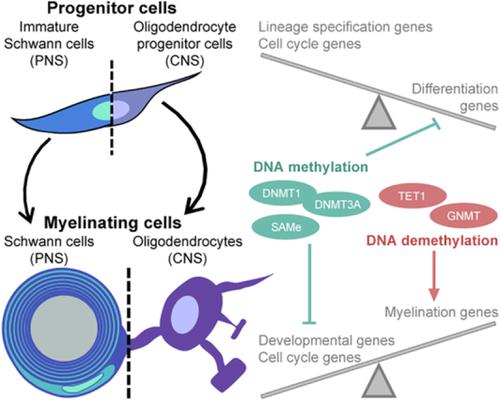Our official English website, www.x-mol.net, welcomes your feedback! (Note: you will need to create a separate account there.)
DNA methylation in Schwann cells and in oligodendrocytes.
Glia ( IF 6.2 ) Pub Date : 2020-01-20 , DOI: 10.1002/glia.23784 Peter Arthur-Farraj 1 , Sarah Moyon 2
Glia ( IF 6.2 ) Pub Date : 2020-01-20 , DOI: 10.1002/glia.23784 Peter Arthur-Farraj 1 , Sarah Moyon 2
Affiliation

|
DNA methylation is one of many epigenetic marks, which directly modifies base residues, usually cytosines, in a multiple‐step cycle. It has been linked to the regulation of gene expression and alternative splicing in several cell types, including during cell lineage specification and differentiation processes. DNA methylation changes have also been observed during aging, and aberrant methylation patterns have been reported in several neurological diseases. We here review the role of DNA methylation in Schwann cells and oligodendrocytes, the myelin‐forming glia of the peripheral and central nervous systems, respectively. We first address how methylation and demethylation are regulating myelinating cells' differentiation during development and repair. We then mention how DNA methylation dysregulation in diseases and cancers could explain their pathogenesis by directly influencing myelinating cells' proliferation and differentiation capacities.
中文翻译:

雪旺细胞和少突胶质细胞中的 DNA 甲基化。
DNA 甲基化是许多表观遗传标记之一,它在多步循环中直接修饰碱基残基,通常是胞嘧啶。它与几种细胞类型中基因表达和可变剪接的调节有关,包括在细胞谱系特化和分化过程中。在衰老过程中也观察到了 DNA 甲基化变化,并且在几种神经系统疾病中已经报道了异常的甲基化模式。我们在这里回顾了 DNA 甲基化在雪旺细胞和少突胶质细胞(分别是外周和中枢神经系统的髓鞘形成神经胶质细胞)中的作用。我们首先讨论甲基化和去甲基化如何在发育和修复过程中调节髓鞘细胞的分化。
更新日期:2020-01-20
中文翻译:

雪旺细胞和少突胶质细胞中的 DNA 甲基化。
DNA 甲基化是许多表观遗传标记之一,它在多步循环中直接修饰碱基残基,通常是胞嘧啶。它与几种细胞类型中基因表达和可变剪接的调节有关,包括在细胞谱系特化和分化过程中。在衰老过程中也观察到了 DNA 甲基化变化,并且在几种神经系统疾病中已经报道了异常的甲基化模式。我们在这里回顾了 DNA 甲基化在雪旺细胞和少突胶质细胞(分别是外周和中枢神经系统的髓鞘形成神经胶质细胞)中的作用。我们首先讨论甲基化和去甲基化如何在发育和修复过程中调节髓鞘细胞的分化。



























 京公网安备 11010802027423号
京公网安备 11010802027423号